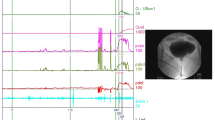Abstract
Introduction and hypothesis
Dysfunctional voiding (DV) is not uncommon in women and is typically challenging to treat. This study retrospectively investigated the long-term treatment outcomes of DV women with different videourodynamics (VUDS) characteristics.
Methods
Data of women with VUDS-proven DV (n = 302) were retrospectively analyzed. All patients at first received biofeedback pelvic floor muscle training and medications; urethral sphincter botulinum toxin A injection was administered after treatment failure. Long-term follow-up outcomes were graded by global response assessment (GRA) and objective responses of decrease of detrusor pressure (Pdet), increase in maximum flow rate (Qmax) and voiding efficiency (VE). The treatment outcomes were investigated among different VUDS subgroups.
Results
Of 302 women, 165 (54.6%) had mid-urethral DV, 117 (38.7%) had distal urethral DV, and 20 (6.6%) had both bladder neck dysfunction (BND) and mid-urethral DV. A total of 170 (56.3%) patients were available for follow-up VUDS after treatment. Pdet was decreased in all three subgroups, but increase in Qmax and VE was only noted in the BND plus DV subgroup. Overall, 120 (70.6%) patients showed improvement (GRA ≥ 1), including 14 with BND plus DV (93.3%), 50 with mid-urethral DV (60.8%) and 56 with distal urethral DV (77.8%) (p = 0.044). All three subgroups showed significant reduction in bladder outlet obstruction index after treatment, with BND plus DV subgroup showing the greatest reduction.
Conclusions
Women with DV have different VUDS characteristics resulting from different pathophysiological mechanisms and treatment results. The VUDS characteristics may help predict treatment outcomes of female DV.


Similar content being viewed by others
Data availability statement
Data are available on request from the corresponding author.
References
Hsiao SM, Lin HH, Kuo HC. Videourodynamic studies of women with voiding dysfunction. Sci Rep. 2017;7:6845.
Haylen BT, de Ridder D, Freeman RM, et al. International Urogynecological Association; International Continence Society. An International Urogynecological Association (IUGA)/International Continence Society (ICS) joint report on the terminology for female pelvic floor dysfunction. Neurourol Urodyn. 2010;29:4–20.
Blaivas JG. Pathophysiology of lower urinary tract dysfunction. Urol Clin North Am. 1985;12:215–24.
Deindl FM, Vodusek DB, Bischoff CH, Hofmann R, Hartung R. Dysfunctional voiding in women: which muscles are responsible? Br J Urol. 1998;82:814–9.
Nitti VW, Fiske J. Cystometrogram versus cystometrogram plus voiding pressure-flow studies in women with lower urinary tract symptoms. J Urol. 1999;161(Suppl):201.
Groutz A, Blaivas JG, Pies C, Sassone AM. Learned voiding dysfunction (non-neurogenic, neurogenic bladder) among adults. Neurourol Urodyn. 2001;20:259–68.
Allen TD, Bright TC 3rd. Urodynamic patterns in children with dysfunctional voiding problems. J Urol. 1978;119:247–9.
Chen YC, Kuo HC. Clinical and video urodynamic characteristics of adult women with dysfunctional voiding. J Formos Med Assoc. 2014;113:161–5.
Peng CH, Chen SF, Kuo HC. Videourodynamic analysis of the urethral sphincter overactivity and the poor relaxing pelvic floor muscles in women with voiding dysfunction. Neurourol Urodyn. 2017;36:2169–75.
Chow PM, Hsiao SM, Kuo HC. Obstructive patterns in videourodynamic studies predict responses of female dysfunctional voiding treated with or without urethral botulinum toxin injection: a long-term follow-up study. Int Urogynecol J. 2020;31:2557–64.
Jiang YH, Lee CL, Chen SF, Kuo HC. Therapeutic effects of urethral sphincter botulinum toxin A injection on dysfunctional voiding with different videourodynamic characteristics in non-neurogenic women. Toxins (Basel). 2021;13:362.
Kuo HC. Dysfunctional voiding in women with lower urinary tract symptoms. Tzu Chi Med J. 2000;12:217–23.
Schäfer W, Abrams P, Liao L, et al. Good urodynamic practices: uroflowmetry, filling cystometry, and pressure-flow studies. Neurourol Urodyn. 2002;21:261–74.
Propert KJ, Mayer RD, Wang Y, et al. Responsiveness of symptom scales for interstitial cystitis. Urology. 2006;67:55–9.
Carson CC, Segura JW, Osborne DM. Evaluation and treatment of the female urethral syndrome. J Urol. 1980;124:609–10.
Chuang FC, Huang KH, Kuo HC. Lower urinary tract symptoms and video urodynamic characteristics of women with clinically unsuspected bladder outlet obstruction. Low Urin Tract Symptoms. 2013;5:23–7.
Minardi D, d’Anzeo G, Parri G, et al. The role of uroflowmetry biofeedback and biofeedback training of the pelvic floor muscles in the treatment of recurrent urinary tract infections in women with dysfunctional voiding: a randomized controlled prospective study. Urology. 2010;75:1299–304.
Lee YS, Lee KS, Choo MS, et al. Efficacy of an alpha-blocker for the treatment of nonneurogenic voiding dysfunction in women: an 8-week, randomized, double-Blind, placebo-controlled trial. Int Neurourol J. 2018;22:30–40.
Espuña-Pons M, Cardozo L, Chapple C, Sievert KD, van Kerrebroeck P, Kirby MG. Overactive bladder symptoms and voiding dysfunction in neurologically normal women. Neurourol Urodyn. 2012;31:422–8.
Kuo HC. Botulinum A toxin urethral injection for the treatment of lower urinary tract dysfunction. J Urol. 2003;170:1908–12.
van Kerrebroeck PE, van Voskuilen AC, Heesakkers JP, et al. Results of sacral neuromodulation therapy for urinary voiding dysfunction: outcomes of a prospective, worldwide clinical study. J Urol. 2007;178:2029–34.
Jiang YH, Chen SF, Jhang JF, Kuo HC. Therapeutic effect of urethral sphincter onabotulinumtoxinA injection for urethral sphincter hyperactivity. Neurourol Urodyn. 2018;37:2651–7.
Kaplan W, Firlit CF, Schoenberg HW. The female urethral syndrome: external sphincter spasm as etiology. J Urol. 1980;124:48–9.
Hinman F Jr. Nonneurogenic neurogenic bladder (the Hinmann syndrome)-15 years later. J Urol. 1986;136:769–77.
De Paepe H, Renson C, Van Laecke E, Raes A, Vande Walle J, Hoebeke P. Pelvic-floor therapy and toilet training in young children with dysfunctional voiding and obstipation. BJU Int. 2000;85:889–93.
Funding
This study was supported by the Buddhist Tzu Chi Medical Foundation, grant no. TCMF-MP 110-03-01.
Author information
Authors and Affiliations
Contributions
CL Lee: methodology, investigation, data collection, manuscript writing
SF Chen: investigation, data collection
YH Jiang: investigation, data collection
HC Kuo: Conceptualization, investigation, data collection, review and editing
Corresponding author
Ethics declarations
Conflicts of interest
None.
Additional information
Publisher’s note
Springer Nature remains neutral with regard to jurisdictional claims in published maps and institutional affiliations.
Rights and permissions
About this article
Cite this article
Lee, CL., Chen, SF., Jiang, YH. et al. Effect of videourodynamic subtypes on treatment outcomes of female dysfunctional voiding. Int Urogynecol J 33, 1283–1291 (2022). https://doi.org/10.1007/s00192-022-05154-0
Received:
Accepted:
Published:
Issue Date:
DOI: https://doi.org/10.1007/s00192-022-05154-0




